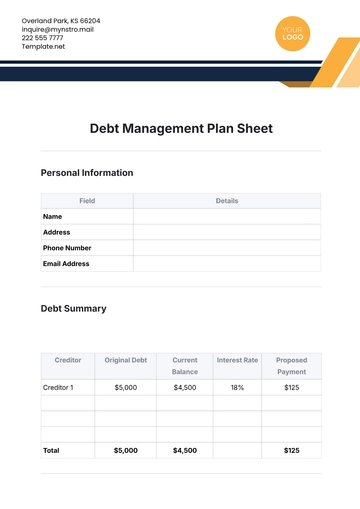Free International Investment Plan

I. Introduction
This plan outlines a structured approach to international investments, guiding market analysis, risk management, and portfolio diversification. It is intended for investors seeking to diversify their assets across global markets while maximizing returns and minimizing risks. The following sections provide detailed insights and strategies for effective international investing.
II. Market Analysis
1. Economic Indicators
Key economic indicators to monitor include GDP growth rates, inflation rates, and employment statistics. Understanding these indicators helps assess the overall health and potential of international markets.
Gross Domestic Product (GDP): Evaluates the economic performance and growth potential.
Consumer Price Index (CPI): Measures inflation, indicating the purchasing power of consumers.
Unemployment Rate: Reflects the labor market's health and potential consumer spending power.
2. Political Stability
Assessing political stability involves understanding the target country's government policies, political risks, and corruption levels. Factors to consider include:
Government Structure: Stability and predictability of the political system.
Corruption Index: Levels of corruption and their potential impact on investments.
3. Legal and Regulatory Environment
Investors must be aware of the legal framework governing investments, including property rights, tax policies, and repatriation of profits. Key considerations include:
Foreign Investment Laws: Regulations governing foreign ownership and investment restrictions.
Taxation Policies: Understanding local tax implications on profits and dividends.
4. Cultural Factors
Cultural understanding can significantly influence investment success. Factors to consider include:
Consumer Behavior: Preferences and spending habits in the target market.
Business Practices: Norms and values that affect business operations and negotiations.
III. Risk Management
1. Currency Risk
Currency risk arises from fluctuations in exchange rates, impacting the value of international investments.
Hedging Strategies: Techniques to mitigate currency fluctuations.
Currency Futures and Options: Financial instruments to protect against adverse currency movements.
2. Political Risk
Political risk includes changes in government, legislation, and policies that could affect investment returns.
Country | Political Risk Rating |
|---|---|
Country A | Low |
Country B | Moderate |
Country C | High |
3. Market Risk
Market risk involves fluctuations in market prices due to economic, political, and environmental factors.
4. Systemic Risk
Systemic risk pertains to broader market risks that can impact multiple sectors simultaneously. Factors to monitor include:
Global Economic Trends: Economic crises or booms that affect various markets.
Natural Disasters: Events that can disrupt markets or supply chains.
IV. Portfolio Diversification
1. Asset Allocation
Diversifying investments across different asset classes can reduce risk and enhance returns. Considerations include:
Equities: Investing in foreign stocks to capture growth.
Bonds: Incorporating international bonds for stable income.
Real Estate: Diversifying through property investments in various markets.
Commodities: Investing in physical goods like gold or oil to hedge against inflation.
2. Geographic Diversification
Investing in different geographic regions helps mitigate region-specific risks, allowing investors to take advantage of growth opportunities in emerging markets while stabilizing returns from developed markets.
3. Sector Diversification
Investing across various sectors (technology, healthcare, consumer goods) can further mitigate risks associated with sector-specific downturns.
V. Implementation Strategy
1. Investment Vehicles
Several vehicles are available for international investments, including:
Mutual Funds: Pooled funds managed by professionals focusing on international markets.
ETFs (Exchange-Traded Funds): Lower-cost alternatives offering exposure to international indices.
Direct Investments: Direct stakes in foreign companies or real estate.
2. Monitoring and Review
Regularly monitoring investments and reviewing the portfolio ensures alignment with investment goals and market conditions. This includes:
Performance Analysis: Evaluating the performance of individual investments and the overall portfolio.
Rebalancing: Adjusting allocations based on market conditions or changes in investment goals.
3. Exit Strategy
Developing a clear exit strategy for each investment can help maximize returns and minimize losses. Considerations include:
Target Return: Establishing benchmarks for when to sell an investment.
Market Conditions: Timing exits based on market trends and economic indicators.
VI. Conclusion
An effective international investment plan requires comprehensive market analysis, diligent risk management, and strategic diversification. By incorporating insights on economic indicators, political stability, legal frameworks, cultural factors, and risk management strategies, this plan equips investors to navigate global markets successfully. Adopting a structured approach allows for achieving a balanced and profitable global portfolio, tailored to individual investment goals.
- 100% Customizable, free editor
- Access 1 Million+ Templates, photo’s & graphics
- Download or share as a template
- Click and replace photos, graphics, text, backgrounds
- Resize, crop, AI write & more
- Access advanced editor
You may also like
- Finance Plan
- Construction Plan
- Sales Plan
- Development Plan
- Career Plan
- Budget Plan
- HR Plan
- Education Plan
- Transition Plan
- Work Plan
- Training Plan
- Communication Plan
- Operation Plan
- Health And Safety Plan
- Strategy Plan
- Professional Development Plan
- Advertising Plan
- Risk Management Plan
- Restaurant Plan
- School Plan
- Nursing Home Patient Care Plan
- Nursing Care Plan
- Plan Event
- Startup Plan
- Social Media Plan
- Staffing Plan
- Annual Plan
- Content Plan
- Payment Plan
- Implementation Plan
- Hotel Plan
- Workout Plan
- Accounting Plan
- Campaign Plan
- Essay Plan
- 30 60 90 Day Plan
- Research Plan
- Recruitment Plan
- 90 Day Plan
- Quarterly Plan
- Emergency Plan
- 5 Year Plan
- Gym Plan
- Personal Plan
- IT and Software Plan
- Treatment Plan
- Real Estate Plan
- Law Firm Plan
- Healthcare Plan
- Improvement Plan
- Media Plan
- 5 Year Business Plan
- Learning Plan
- Marketing Campaign Plan
- Travel Agency Plan
- Cleaning Services Plan
- Interior Design Plan
- Performance Plan
- PR Plan
- Birth Plan
- Life Plan
- SEO Plan
- Disaster Recovery Plan
- Continuity Plan
- Launch Plan
- Legal Plan
- Behavior Plan
- Performance Improvement Plan
- Salon Plan
- Security Plan
- Security Management Plan
- Employee Development Plan
- Quality Plan
- Service Improvement Plan
- Growth Plan
- Incident Response Plan
- Basketball Plan
- Emergency Action Plan
- Product Launch Plan
- Spa Plan
- Employee Training Plan
- Data Analysis Plan
- Employee Action Plan
- Territory Plan
- Audit Plan
- Classroom Plan
- Activity Plan
- Parenting Plan
- Care Plan
- Project Execution Plan
- Exercise Plan
- Internship Plan
- Software Development Plan
- Continuous Improvement Plan
- Leave Plan
- 90 Day Sales Plan
- Advertising Agency Plan
- Employee Transition Plan
- Smart Action Plan
- Workplace Safety Plan
- Behavior Change Plan
- Contingency Plan
- Continuity of Operations Plan
- Health Plan
- Quality Control Plan
- Self Plan
- Sports Development Plan
- Change Management Plan
- Ecommerce Plan
- Personal Financial Plan
- Process Improvement Plan
- 30-60-90 Day Sales Plan
- Crisis Management Plan
- Engagement Plan
- Execution Plan
- Pandemic Plan
- Quality Assurance Plan
- Service Continuity Plan
- Agile Project Plan
- Fundraising Plan
- Job Transition Plan
- Asset Maintenance Plan
- Maintenance Plan
- Software Test Plan
- Staff Training and Development Plan
- 3 Year Plan
- Brand Activation Plan
- Release Plan
- Resource Plan
- Risk Mitigation Plan
- Teacher Plan
- 30 60 90 Day Plan for New Manager
- Food Safety Plan
- Food Truck Plan
- Hiring Plan
- Quality Management Plan
- Wellness Plan
- Behavior Intervention Plan
- Bonus Plan
- Investment Plan
- Maternity Leave Plan
- Pandemic Response Plan
- Succession Planning
- Coaching Plan
- Configuration Management Plan
- Remote Work Plan
- Self Care Plan
- Teaching Plan
- 100-Day Plan
- HACCP Plan
- Student Plan
- Sustainability Plan
- 30 60 90 Day Plan for Interview
- Access Plan
- Site Specific Safety Plan





























